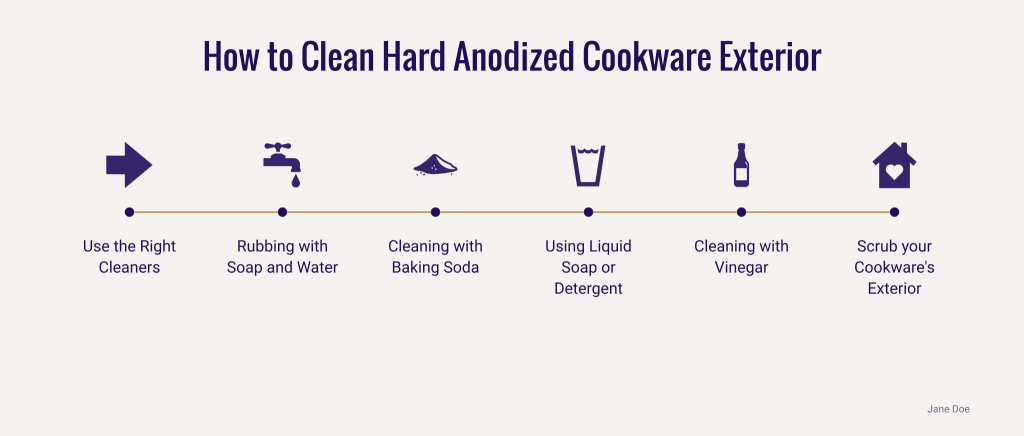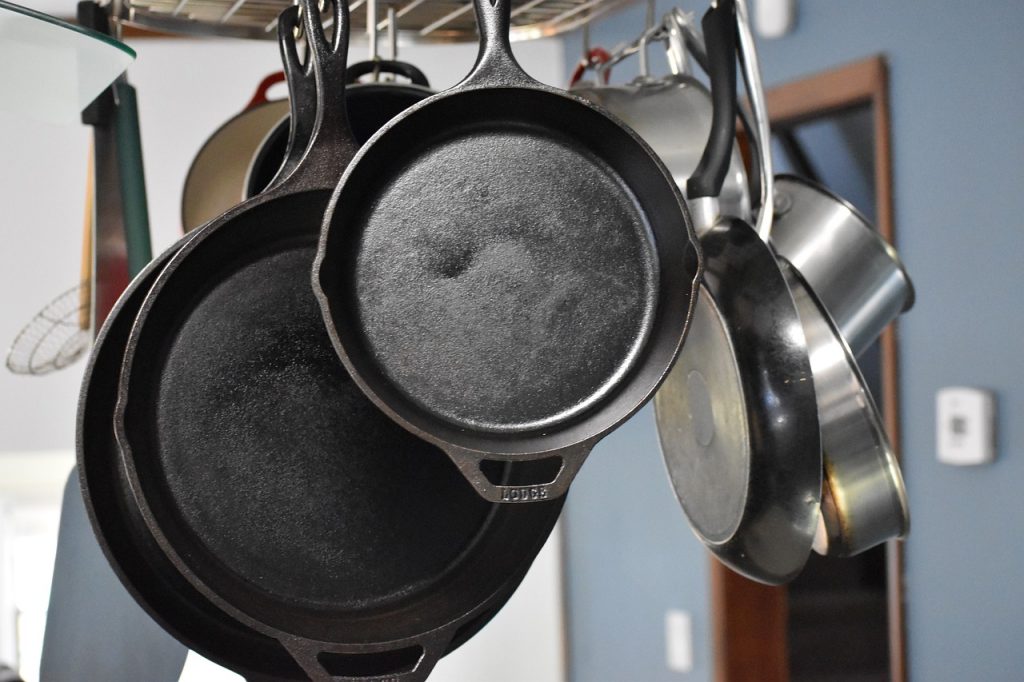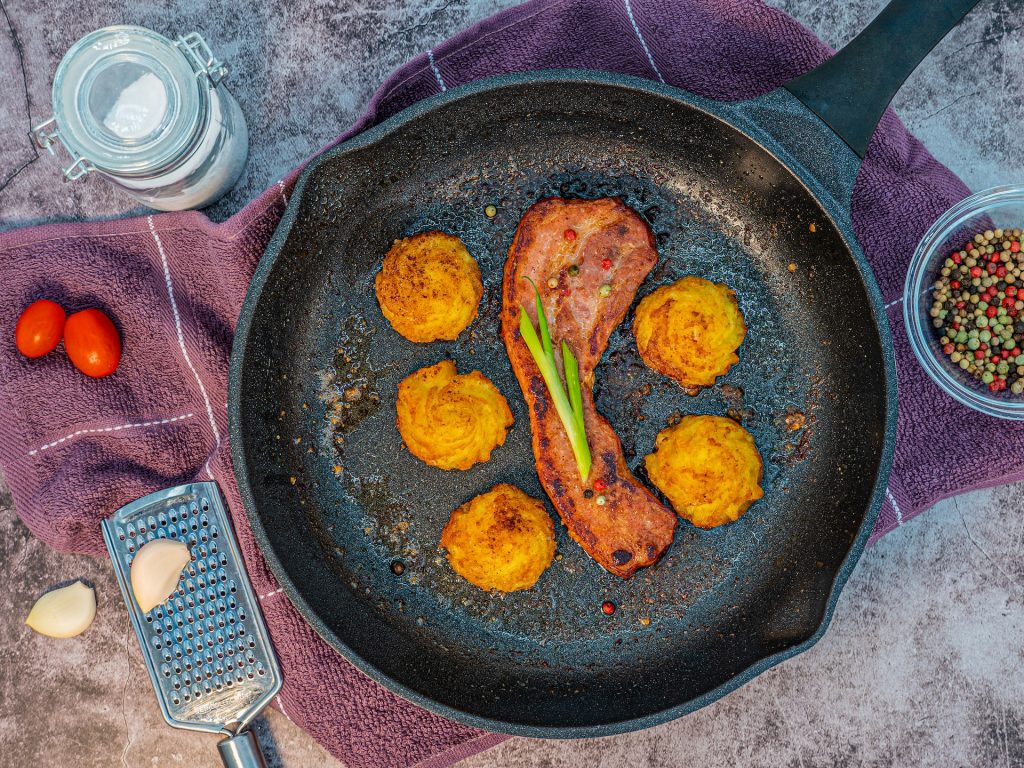Have you heard of hard anodized cookware but have no idea what it is or how it differs from regular pots and pans? Or do you already have one but have no idea how to clean hard adonized cookware exterior?
Hard anodized cookware is a great choice for home cooks looking for something that won’t break down easily or requires extra maintenance to keep it in good condition. This article will discuss how to clean hard anodized cookware exterior in 6 easy ways.
What is Hard Anodized Cookware?

Hard anodized cookware is created through a process known as electrochemical hardening. This process takes ordinary aluminum pots and pans and transforms them into pieces of cookware that are highly durable and resistant to scratches, dents, and other types of wear and tear. The result is a piece of cookware that has been hardened on the outside while remaining lightweight inside, making it perfect for everyday use.
Benefits of Hard Adonized Cookware
One of the biggest benefits of hard anodized cookware is its durability. Unlike traditional aluminum pots and pans, which can easily be scratched or dented over time, hard anodized cookware will not become damaged, no matter how rough you are with it while cooking or cleaning up after meals.
It makes it perfect for busy households with no time to be extra gentle with kitchen tools. Another benefit of hard anodized cookware is its nonstick capabilities; food won’t stick to the surface when cooking because it does not allow food particles to adhere to it. It means less scrubbing for you!
Plus, most hard anodized pieces come with lids that fit snugly onto each pot or pan, making them great for storing leftovers in the fridge without having to worry about spills later on down the line.
The downside of Hard Anodized Cookware
Hard anodized cookware is not for extremely high-heat cooking. While it is great for everyday use, it would be best not to use it when cooking at extremely high temperatures, as this can cause the cookware to warp and become damaged. It would be best to avoid high heat with over 500°F. Otherwise, you risk warping the cookware and ruining its nonstick capabilities.
Hard anodized cookware can be expensive compared to other pots and pans. A single pan can range anywhere from $30 to $100 depending on size and brand name, which means you could spend a lot if you buy a full set for your kitchen. This cost may not be feasible for some people, so make sure you factor it into your budget before making any purchases!
How to Clean Hard Anodized Cookware Exterior

Anodized cookware is popular for its durability but can be difficult to keep clean. The exterior of hard anodized cookware is often covered with a nonstick coating, which makes it susceptible to scratches and residue buildup. Thankfully, you can take steps to keep your cookware looking great.
🧽Use the Right Cleaners
Since hard anodized cookware is made from aluminum, it’s important to use non-abrasive cleaning products specifically designed for this material. These include dish soap and warm water, baking soda, white vinegar, and lemon juice.
🧽Rubbing with Soap and Water
If your cookware has minor stains or food residue on the outside, you can use regular soap and water to scrub away the mess. Make sure to use a soft sponge or cloth so as not to scratch up the exterior of your pans. If you find that soap and water aren’t enough, try using baking soda as a gentle abrasive that can help remove stubborn stains.
🧽Cleaning with Baking Soda
Baking soda is a gentle yet effective way to remove stubborn dirt or residue from the exterior of hard anodized cookware. Create a paste by mixing baking soda and water, then spread it over the cookware’s surface using a soft cloth. Let it rest for 5 minutes before wiping away any excess paste with another cloth. Finally, use a microfiber cloth to buff the surface until it shines.
🧽Using Liquid Soap or Detergent
If baking soda isn’t enough to remove dirt or residue from your anodized cookware, try using liquid soap or detergent. Mix a few drops into warm water and soak the pan for 15 minutes before scrubbing gently with a soft brush or damp cloth. You can also create a paste with liquid soap and water and apply it directly onto your pan in the same manner as mentioned above with baking soda. Whichever method you choose, make sure that you rinse off any remaining soap residue once you’ve finished cleaning!
🧽Cleaning with Vinegar
Vinegar is another great option for cleaning hard anodized exterior surfaces. Simply mix equal parts vinegar and water in a spray bottle, then spritz over your pan’s surface until saturated. Let it sit for 10-15 minutes before wiping away any remaining grime with a damp cloth or sponge before rinsing thoroughly under hot running water. This method works especially well if you want to eliminate stubborn grease stains!
🧽Scrub your Cookware’s Exterior
You can use a scouring product to remove any stains or burns from your cookware. Make a paste by mixing mild scouring powder, baking soda, and water. Use a soft-bristled brush or a dishcloth to rub the paste onto the stain. Rise with hot water and wipe dry with a cloth.
How To Clean Hard Anodized Cookware Interior

Hard anodized cookware is a great kitchen staple for any home. It is incredibly durable, heat resistant, and non-toxic. But after lots of use, it can become stained and discolored. If your hard anodized cookware needs a deep clean, this post has you covered.
Here’s how to safely clean the interior of your hard anodized cookware.
💧Wash Your Cookware Before Using
You might be eager to use your newly purchased hard anodized cookware. It is important to clean your cookware, even if it’s brand new. Wash with warm, soapy water and a clean cloth to remove any residue from the manufacturing process.
💧Clean it After use
Have you ever noticed grease buildup in nonstick cookware? It looks awful. It’s best to wash your nonstick hard anodized pans and pots before you use them.
Experts recommend washing pots and pans immediately after each usage. Submerging hot nonstick cookware made from hard anodized in hot water is okay because it prevents it from getting warped.
💧Immerse the Cookware in a Dish Soap Solution
If you’re dealing with stubborn grease and grime, it is time to take more drastic measures. To clean your hard anodized cookware interior, fill a sink or large bowl with hot water and liquid dish soap. Submerge your pots and pans in the soapy solution until all dirt, grease, and food residue is loosened.
Immerse the cookware in the water for about 20 minutes. Then, get the kitchenware and cool it down for at least 30 minutes.
💧Use a Nylon Scrubber
Once the cookware is cooled down, scrub each pot and pan with a nylon scrubber. To ensure that you have removed the grime, use a soft cloth or sponge to wipe away any excess dirt.
💧Clean it with Cream Of Tartar
It is time to get creative if you’re still dealing with stubborn grease. Cream of tartar can make a paste that will help remove the last bits of grime and debris from your hard anodized cookware interior.
Mix cream of tartar with a bit of water until it forms a thick paste. Then, apply the paste to your pan’s interior and let it sit for 15 minutes. Finally, wipe away any residue with a damp cloth or sponge.
How to Remove Stains from Hard-Anodized Cookware

If your cookware has become stained, it is important to take the necessary steps to remove these stains. You can use several methods to get rid of stubborn stains from hard-anodized cookware.
✅Baking Soda and Vinegar Method
This method effectively removes grease and food particles that have become stuck on the surface of your hard-anodized cookware. Simply mix baking soda and vinegar in a bowl until they form a paste. Spread the paste over the stained area and let it sit for 30 minutes before scrubbing with a sponge or cloth. Once you’ve removed as much of the stain, rinse with warm water and dry with a soft cloth.
✅Bar Keepers Friend Method
For really tough stains, Bar Keepers Friend is an excellent choice since its specialty formula is designed specifically for cleaning hard surfaces like anodized aluminum cookware. To use this method, sprinkle some Bar Keepers Friend onto the affected area and then dampen it with either white vinegar or water mixed with lemon juice (for extra cleaning power).
Rub in circular motions using a damp sponge or cloth until all traces of dirt are gone, then rinse thoroughly with warm water and dry completely with a soft cloth or paper towel.
✅Using an Aluminum Foil Ball
If you’re dealing with burnt-on food residue or discoloration, try creating an aluminum foil ball by crumpling up a piece of foil about the size of a baseball. Place the aluminum foil ball in your pan and fill it with warm water until the bottom is full of about two inches of liquid.
Heat medium heat until boiling, then reduce heat and simmer for five minutes. Carefully remove from heat and let cool before using a wooden spoon to scrape away residue before washing normally with soap and water.
✅Lemon Juice Method
For tougher stains such as burnt food or discoloration, lemon juice is an excellent way to get your hard-anodized cookware looking like new again. First, fill the affected pan with water and add one cup of lemon juice. Bring the mixture to a boil and let it simmer for 10 minutes before pouring out all but one cup of liquid.
Next, use a wooden spoon to scrape away any remaining residue from the pan’s surface before rinsing it with warm water and drying thoroughly with a soft cloth.
You may also want to add baking soda to this method for additional cleaning power. Make sure not to use too much, as this could scratch your pan’s surface!
How to Care for Your Hard Anodized Cookware

To ensure your hard anodized cookware lasts as long as possible, there are certain things you should avoid when cleaning it. Let’s look at the proper care and maintenance of this popular cookware.
🧡Season Your Hard Anodized Cookware
Seasoning your hard anodized cookware will help protect it from scratches, wear and tear, and even rust. It is similar to how one season cast iron pots and pans. The oxidation process already protects these products. However, some users prefer to season their pans.
Season hard anodized aluminum by washing the cookware first, removing any packing material, and drying it with a towel.
Place the cookware on the stovetop at high heat and add the cooking oil. Spread the cooking oil using a new sponge. Let the cookware heat up until the oil starts to smoke. Then, let it cool.
After the cookware has cooled, use a paper towel to remove any oil and store it properly. It would be best to wash your cookware only with warm water after seasoning. The pan might need to be re-seasoned if you use soap.
🧡Avoid Scrubbing with Harsh Abrasives or Steel Wool
To keep your hard anodized cookware looking new, avoid scrubbing it with harsh abrasives or steel wool pads. These abrasive materials can damage the exterior finish of the metal and can reduce its ability to be nonstick. Opt for soft cloths when cleaning your hard anodized cookware, and avoid using harsh chemicals that could corrode the metal over time.
🧡Don’t Wash It Using the Dishwasher
The interior of the pans mustn’t touch any surface, as this will cause the coating to wear off.
You might not want to wash your anodized cookware in a dishwasher. While some brands may claim they are dishwasher-safe, the consensus is that it would reduce their lifespan.
Dishwasher detergent can be very harsh. Add that to the dishwasher’s temperature and pressure, and you could cause damage to the nonstick coating.
Dishwasher use can also cause nonstick coatings to chip, peel, or become less effective. It could lead to lots of burned meals. You don’t want the warranty on hard-anodized pots to be void.
Ensure that the manufacturer states that the cookware is dishwasher safe.
🧡Avoid Air Drying
After washing your hard anodized cookware, dry it off completely before storing it. Allowing your cookware to air dry can cause water spots on the surface, damaging the finish over time. Instead, towel dries your pans immediately after washing them to prevent any damage from occurring.
🧡Harsh Chemicals
Harsh chemicals such as bleach should also be avoided when cleaning hard anodized cookware as they can damage the protective coating on the pans and pots over time. For the best results, stick with mild detergents and warm water. If you need something stronger than soap and water, opt for baking soda instead – just make sure to thoroughly rinse away any residue after use.
🧡Don’t Submerge Your Hot Cookware in Cold Water
It is important to remember that hard-anodized cookware can be susceptible to thermal shock, which is why you should never submerge your hot pans or pots in cold water. The sudden temperature change can cause the metal to warp and the coating to become damaged. Instead, let the cookware cool down before washing it with warm, soapy water.
🧡Avoid Metal Utensils
Metal utensils such as spatulas and spoons can damage your hard anodized cookware over time by scratching its surface or creating small dents in its metal exterior. To avoid this, use wooden or silicon utensils instead. These are gentler on the surface and won’t cause any lasting damage. Make sure all utensils are clean before using them with your hard anodized cookware too!
Frequently Asked Questions
What is the difference between anodized and hard anodized?
Anodized cookware is made of aluminum treated with an electrical current. It creates a chemical reaction in the metal, hardening it to create a scratch-resistant and non-corrosive surface. Hard anodized cookware takes this process further by electrochemically oxidizing the aluminum multiple times, making it even harder and more durable.
Is it safe to cook with hard anodized cookware?
Yes, hard anodized cookware is safe to cook with. The metal is non-toxic and does not leach into your food. It also has a low reaction rate with acidic and alkaline substances, making it a great choice for cooking.
Can I place hard-anodized cookware in the oven?
Yes, you can put hard-anodized cookware in the oven. It is oven-safe up to 600°F. Be sure to check the manufacturer’s instructions for any specific temperature guidelines. Also, ensure your cookware has a metal handle, as plastic handles may melt if exposed to high temperatures.
How do I polish hard anodized cookware?
Polishing hard anodized cookware is unnecessary as its nonstick finish should remain intact. If it does become dull, use a silicone-based polish to restore its shine. Do not use abrasive cleaners or steel wool, as these can damage the coating and make it less effective.
Can I restore hard anodized cookware?
You can restore hard anodized cookware if it becomes scratched or damaged. Use a silicone-based polish to restore its shine and luster while protecting the coating from further damage. Be sure to follow the manufacturer’s instructions on how best to use the product.
How long does hard anodized cookware last?
Hard anodized cookware can last up to 10 years when properly cared for. Be sure to hand wash the pans and pots with mild detergent, avoid using metal utensils, and never submerge your hot cookware into cold water. These tips will help keep your hard anodized cookware in top condition for many years.
Final Words
No matter how carefully you use hard-anodized cookware, there’s always a chance it will get stained over time. Cleaning hard anodized cookware may seem daunting, but with these steps, it doesn’t need to be!
Start by using only non-abrasive sponges or cloths to avoid scratching the surface of your pans. When removing stuck-on food particles or grease from their interior surfaces, take advantage of soaking solutions such as vinegar and baking soda paste for tough stain removal.
With proper care and maintenance, you’ll enjoy all the benefits of hard anodized cookware without worrying about damaging it.
